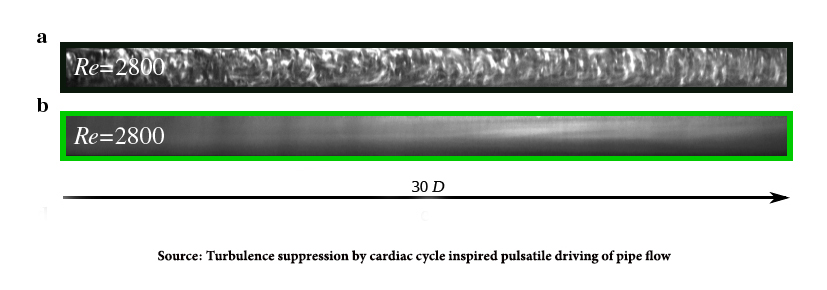As a vascular surgeon, the underlying physics explaining the biological system we care for, our arteries and veins, is well understood. But in many instances, the systems we built to carry fluids in the real world have been based more on “the laws of physics” than the “lessons of biology.”
“Fluid transport is one of the largest sources of energy consumption in present-day societies and a major part of pumping costs can be attributed to turbulence.”
When flow moves at a rate where the adjacent layers do not mix, laminar flow, the energy necessary to move the fluid from point a to b, is at its lowest. In the presence of the mixing of the layers, turbulence, liquids move in many directions, and the energy necessary rises. Turbulence, as best we understand, comes about because of obstructions, say the flow divider separating the arteries going to our left and right legs, and the speed at which the fluid moves – faster results in more significant turbulence. [1]
Ketchup explains the problem
Engineers have modified our pumping systems to reduce turbulence, altering the geometry of pipes and the friction between the fluids and the pipe’s walls. A new study changes the pump, mimicking a system that has evolved over the millennia – our heart.
“Like any part of our bodies, the human heart has been shaped by millions of years of evolution. Unlike common mechanical pumps, which create a steady stream of liquid, the heart pulsates. We were curious if there may be an advantage to this peculiar propulsion form.”
- Björn Hof, Professor Institute for Science and Technology Austria

The images show the flow of water through a clear tubing. The turbulence is highlighted by shining a laser through the pipe. The top image shows the turbulence created as a pump continuously moves fluid—the middle image when the pump works like our heart.
When we consider the flow of blood into the primary distributive pipe, the aorta, the flow is pulsatile – with a big push during the contraction of the heart, systole, and then a pause and slowing of the fluid, as the heart refills, diastole. It appears that the pause is responsible for reducing overall turbulence, allowing the turbulence of systole to die down and returning the flow to near its original state before the next pulsatile wave.
Reducing turbulent blood flow is essential to our physiology because it prevents the lining of our arteries and veins, the endothelium, from being sheared off. Additionally, turbulent flow increases the amount of time one volume of blood comes into contact with the endothelium, a condition that promotes clotting and the formation of atherosclerotic plaques. From an engineering perspective, pulsatile pumping reduces the system's energy needs by about 10% - a non-negligible savings.
[1] Turbulent flow is everywhere in the real world, including the weather and ocean currents. It is perhaps best described by the Navier–Stokes equations. You can go down that rabbit hole here.
Source: Turbulence suppression by cardiac cycle inspired pulsatile driving of pipe flow Nature. DOI: 10.1038/s41586-023-06399-5

